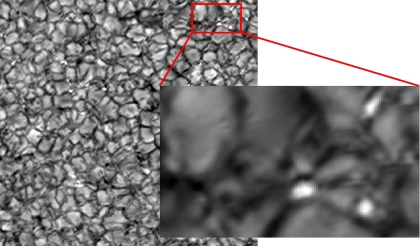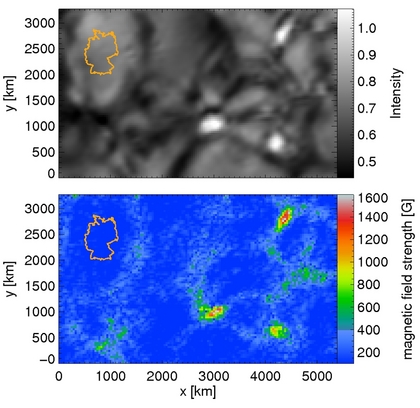Press Release 14/2010 - November 5, 2010
SUNRISE reveals Sun's magnetic building blocks
The first results of the Sunrise mission led by the Max Planck Institute for Solar System Research have now been published.
Scientists from the Max Planck Institute for Solar System Research (MPS) in Germany have now for the first time uncovered and characterized the smallest building blocks of the Sun's magnetic field. In these tiny regions of only a few hundred kilometers in diameter the strength of the magnetic field exceeds the Earth's magnetic field strength by a factor of approximately 3000. Researchers from the MPS, the Kiepenheuer-Institut for Solar Physics and further partner institutions analyzed data gathered last year with the help of the solar observatory Sunrise. Until now, no other solar telescope was able to determine the exact properties of these structures. These and further first results of the Sunrise mission have now been published in twelve articles by the Sunrise-team in a special edition of the Astrophysical Journal. (The Astrophysical Journal Letters, 723, L127 - L189).
The Sun is a turbulent place. Hot plasma is constantly in motion, wells up from the hot interior of our star, cools and sinks down again. In the photosphere, the visible surface of the Sun, these bubbling flows create net-like structures a few thousand kilometres in diameter. Underneath the bright, hot regions the plasma bubbles to the surface. In the dark, cooler rims it recedes again (see Figure 1). Scientists refer to these patterns as granulation.

|
Figure 1: This image taken by the instrument IMaX shows the granulation in the Sun's photosphere. In the bright regions hot plasma wells to the surface; in the dark regions the cooled plasma sinks down again. In between tiny, bright spots can be seen. The individual granules have a size of several thousand kilometers. The bright points measure approximately 100 kilometers in diameter.
|
(Credits: MPS)
|
Since the kinetic energy of these flows of hot plasma can transform into magnetic energy, the currents within the Sun are closely linked to the star's magnetic properties. One expression of this magnetic nature are the dark sunspots that can even exceed the Earth in size. However, the Sun's magnetic field also consists of much smaller structures. Tiny, bright points between the granules are an indicator of these fields. Within the bright points strong magnetic fields squeeze the bubbling plasma outward so that it is possible to look deeper within the Sun's interior. Due to the higher temperatures there, these bright points appear brighter than their surroundings.
Even though several solar telescopes are able to visualize these bright points, their physical properties such as the magnetic field strength could not be identified until now. "Without this knowledge one of the most important requirements for a fundamental understanding of the magnetic processes within the Sun was missing", explains Prof. Dr. Sami K. Solanki, Managing Director of the MPS. It was like trying to study an anthill without being able to discern and describe the individual ants.
Only the solar observatory Sunrise built and operated by an international team headed by the MPS unites the crucial properties: a high spatial resolution of about 100 kilometers and precise instrumentation for measuring physical parameters such as the magnetic field. During the observatory's flight in June of last year, a balloon filled with helium carried Sunrise up to a height of 37 kilometers into the stratosphere. There, Sunrise had left the largest part of Earth's atmosphere behind - and thus the perturbating influences of air turbulences. With a main mirror of one meter in diameter, the Sunrise telescope is the largest solar telescope ever to have left the Earth. In addition, unlike earthbound telescopes Sunrise was also able to study the Sun's ultraviolett (UV) radiation that is essentially absorbed by the Earth's atmosphere and doesn't reach the ground.
"Sunrise's instrumentation reached a resolution of 100 kilometers", explains Solanki. This can be compared to discerning a one-euro coin from a distance of 30 kilometers. Because of this high resolution, it was possible to characterize the bright points within the photosphere for the first time. With up to 1.8 Kilogauss the magnetic field in these regions is approximately 3000 times as strong as the Earth's magnetic field. The temperature is approximately 1000 degrees higher than in the areas surrounding the bright points. "Additional theoretical calculations imply that these hot magnetic structures correspond to individual magnetic flux tubes", says Dr. Andreas Lagg from MPS. They are the building blocks of the solar magnetic field. In the photosphere, their magnetic field lines lie perpendicular to the Sun's surface - like tubes.

|
Figure 2: The bright points in the Sun's photosphere indicate strong magnetic fields. Top: This image taken by the instrument IMaX shows the intensity of the bright points and their surroundings. Bottom: The corresponding strength of the magnetic field. In both images the size of Germany is included for comparison.
|
(Credits: MPS)
|
Apart from that, the scientists were able to determine the brightness of the bright points for the first time - also in the UV. It is approximately five times higher than in the surrounding area. "With this information it is possible to estimate the contribution of the bright points to the total radiation variability of the Sun", says Tino Riethmüller from MPS. Since the Earth's atmosphere absorbs the UV radiation almost completely, this part of the Sun light plays an important role in the heating of the upper air layers. This knowledge is therefore crucial for climate research, since it holds the key to discerning the man-made part of global warming from the Sun's influences. The variation of the brightness within the photosphere, that Sunrise makes visible like no other mission before, also shows the temperature profile at the Sun's surface.
In June 2009 the solar observatory Sunrise started from Esrange Space Center in Kiruna (Sweden) on its 130 hour flight around the north pole. The mission was led by the MPS. Apart from a solar telescope and refined mechanisms for image stabilization, the observatory also carried two instruments that measured the solar magnetic fields. SuFI (Sunrise Filter Imager) was developed under the lead of the MPS, IMaX (Imaging Magnetograph eXperiment) was created in a Spanish consortium headed by the Instituto des Astrofisica de Canarias. Further partners were the Kiepenheuer Institute for Solar Physics in Freiburg (Germany) and the High Altitude Observatory in Boulder, Colorado.
Additional Information
 SUNRISE-Homepage at MPS
SUNRISE-Homepage at MPS
 The mission's internet-dairy
The mission's internet-dairy
Contact
Dr. Birgit Krummheuer
Press and Public Relations
Max Planck Institute for Solar System Research
Max-Planck-Straße 2
37191 Katlenburg-Lindau
Tel.: 05556 979 462
Fax: 05556 979 240
Mobil: 0173 3958625
Email: krummheuer mps.mpg.de
mps.mpg.de
Prof. Dr. Sami K. Solanki
Max Planck Institute for Solar System Research
Max-Planck-Straße 2
37191 Katlenburg-Lindau
Tel: 05556 979 325
Email: solanki mps.mpg.de
mps.mpg.de
Dr. Achim Gandorfer
Max Planck Institute for Solar System Research
Max-Planck-Straße 2
37191 Katlenburg-Lindau
Tel: 05556 979 397
Email: gandorfer mps.mpg.de
mps.mpg.de
Dr. Peter Barthol
Max Planck Institute for Solar System Research
Max-Planck-Straße 2
37191 Katlenburg-Lindau
Tel: 05556 979 356
Email: barthol mps.mpg.de
mps.mpg.de
Dr. Andreas Lagg
Max Planck Institute for Solar System Research
Max-Planck-Straße 2
37191 Katlenburg-Lindau
Tel: 05556 979 465
Email: lagg mps.mpg.de
mps.mpg.de
Tino Riethmüller
Max Planck Institute for Solar System Research
Max-Planck-Straße 2
37191 Katlenburg-Lindau
Tel: 05556 979 375
Email: riethmueller mps.mpg.de
mps.mpg.de
